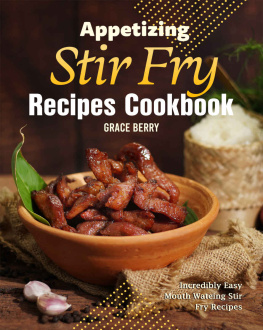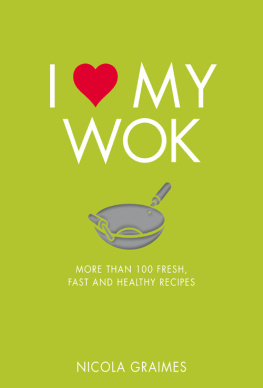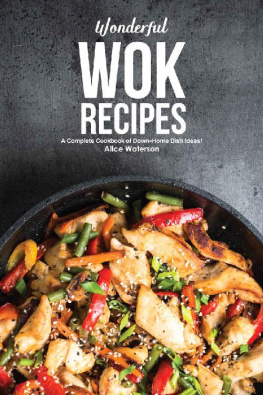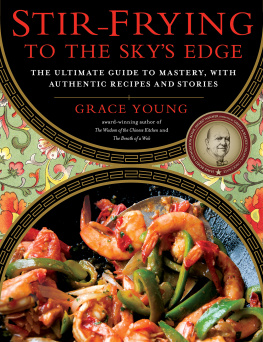Contents
Introduction
STIR-FRYING DATES BACK OVER two millennia to China where hot fires were created in brick stoves. Typically the stovetops had an opening directly over the flames where an inverted domed pan, called a wok, could snuggly fit. Classic woks are roundbottomed and direct the heat toward the central area of the pan. The rounded shape also lends well to the curved spatula often used when stir-frying to assist in the handling of the food. Modern-day woks are now available with flat bottoms in order for them to sit flush on electric and gas ranges.
The key to success with stir-frying is to have all of your items prepared and organized (your mise en place) before you begin the actual cooking. You will want all of your produce and aromatics chopped up in small pieces so that they can be quickly and evenly cooked. Your wok or pan should be heated so that it is nice and hot before you add ingredients to it. Typically when you stir-fry, you will want to use your wrist to create a shaking motion to toss the ingredients around; however, some recipes will ask for you to allow the ingredients to sear in the wok/pan before moving it around. As for deep-frying in woks/pans, you will also want to gently move the ingredients around in the oil, flipping the food often to create an even fry.
There are an overwhelming number of benefits to stir-frying. Not only is the cooking process usually quick once you have your mise en place together, but it is also quite forgiving. Recipes are simply loose guidelines. If you do not have one product, you can substitute with another ingredient for an equally delicious result. Measurements are also only suggested amounts. For example, if a recipe lists 1 tablespoon soy sauce, taste it first and adjust according to your salt-level preference.
Sauting is also quite similar to stir-frying. Both methods require a little preparation before the cooking process begins and use a high level of heat to cook the ingredients. Whereas stir-frying traditionally uses woks, sauting typically employs a large skillet. However, the sides of both pans allow for the tossing and flipping of the ingredients while they cook. The other difference is that traditional sauting employs a combination of oil and butter for the cooking fat. The belief is that butter offers a richer flavor to a dish, and the combination of oil helps increase the smoking point so that the butter does not burn. With that said, do not limit your stir-fries to only Asian dishes as the method can be applied to dishes from all over the world.
When it comes to stir-frying, your only limit is your imagination!
CHAPTER 1
Stir-Fry Essentials
As our society becomes more interested in healthy eating and the quality of the foods we are putting into our bodies, cooking at home is more popular and exciting than ever. Food movements such as farm to table and the desire to eat sustainable foods have inspired us to take more responsibility for how and what we eat. Stir-frying lends well to this shift because the quick cooking allows diners to focus on the true flavor of the ingredients while saving valuable time in the kitchen. The average time for stir-frying a dish is only five to seven minutes. Better still, stir-frying is one of the simplest cooking techniques to learn. All it takes are a few cooking tips and the right ingredients and youre ready to start stir-frying!
The Art of Stir-Frying
Basically, stir-frying involves cooking food at high heat in a small amount of oil. With a few exceptions (such as allowing beef to sear briefly when it is first added to the pan), its important to keep the ingredients moving constantly during stir-frying. The constant stirring motion ensures that all the food comes into contact with the bottom surface of the pan, where the heat is most intense. It also keeps the food from sticking to the pan.
Getting Ready to Stir-Fry
While the technique of stir-frying is quite straightforward, there are a few basic principles that make the process of stir-frying go more smoothly. Its important to organize your mise en place, that is, prepare all the ingredients ahead of time and have those items close to your wok or pan. Once you start stir-frying, you wont have time to chop an onion or measure out the ingredients for a sauce to add at the end. Organization is essential for a smooth stir-fry process.
Most stir-fry recipes call for meat, poultry, or seafood to be marinated prior to stir-frying. A marinade helps tenderize meat, and its a great way to add extra flavor to a stir-fry. In most cases you will want to start marinating the meat before doing anything else as it will require the longest inactive time. While meat is marinating, take the opportunity to focus on the remaining prep work, such as chopping vegetables, preparing a sauce, and cooking rice.
Whenever possible, try to cut the stir-fry ingredients into uniform-sized pieces so that they will take approximately the same amount of time to cook. Make sure vegetables are thoroughly dry before adding them to a stir-fry; wet vegetables wont cook properly and can cause the hot oil to spatter. Canned vegetables should be rinsed and drained to remove excess sodium and flush any flavors the canning process may have imparted. If using frozen vegetables such as spinach, thaw and drain them well before adding them into the wok. Frozen vegetables that retain less water such as edamame beans or peas can be added directly into the wok without thawing.
The Basics of Stir-Frying
The process of stir-frying will unfold smoothly if you follow these basic guidelines:
- Make sure that all the ingredients for the stir-fry are near the stove, so that you can reach for them quickly.
- Add the oil to a preheated pan, tilting the pan so that the oil drizzles along the sides. Since the ingredients will be moving around the wok, it is important the sides are well oiled.
- Before adding the main ingredients, add the aromatics such as ginger and garlic to flavor the oil.
- If the stir-fry includes meat or poultry, add that first. Let it sear briefly, then stir-fry until it changes color and is nearly cooked through. (The beef should have no trace of pink, and the chicken should have turned white.)
- When adding vegetables, add the thicker, denser vegetables first, as they will take more time to cook. Feel free to add a small amount of water or soy sauce if the vegetables begin to dry out during stir-frying.
Keep these instructions in mind as you try the recipes in the following chapters.
Wok Versus Frying Pan
Selecting the wrong equipment can turn stir-frying from a quick and easy task into an exercise in frustration. The right equipment, on the other hand, will help ensure a successful result. When it comes to cooking equipment, the most important decision youll need to make is what type of pan to use. Asian cuisine cooks traditionally use a wok for many types of cooking, from steaming to stir-frying. With its high, sloping sides and rounded or flat bottom, the woks unusual design is perfect for stir-frying. Unlike with a standard frying pan, in a wok you can stir and toss food with ease without worrying about it winding up on the floor. The wok bottom also rests directly on the heat source, allowing food to cook more quickly. Many popular cookware stores now carry woks and other international cookware. However, you can also purchase them through online vendors.












